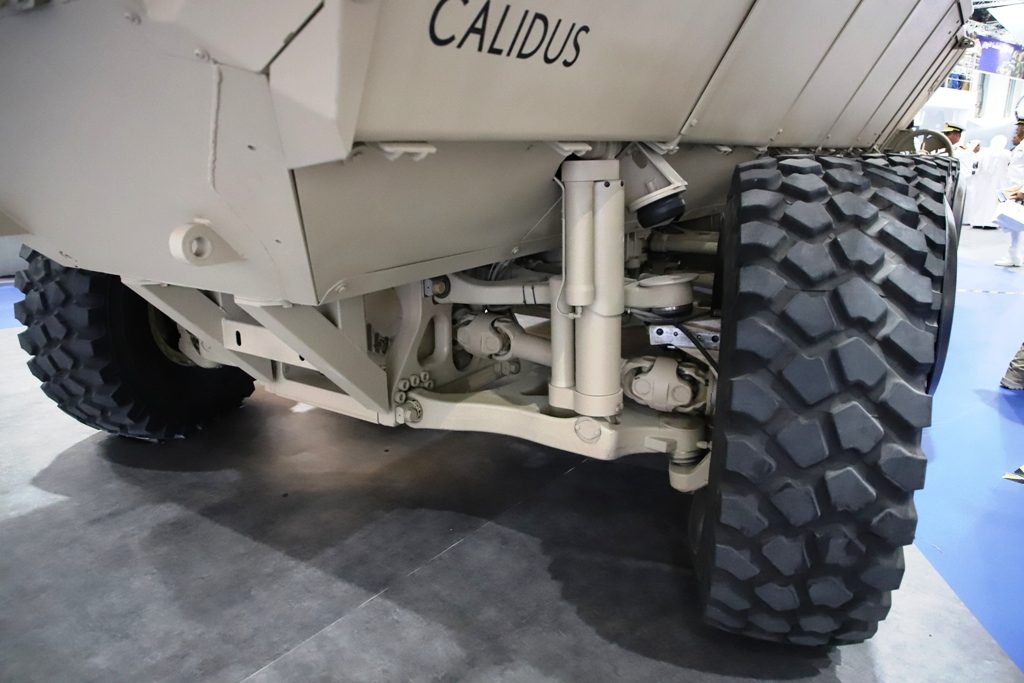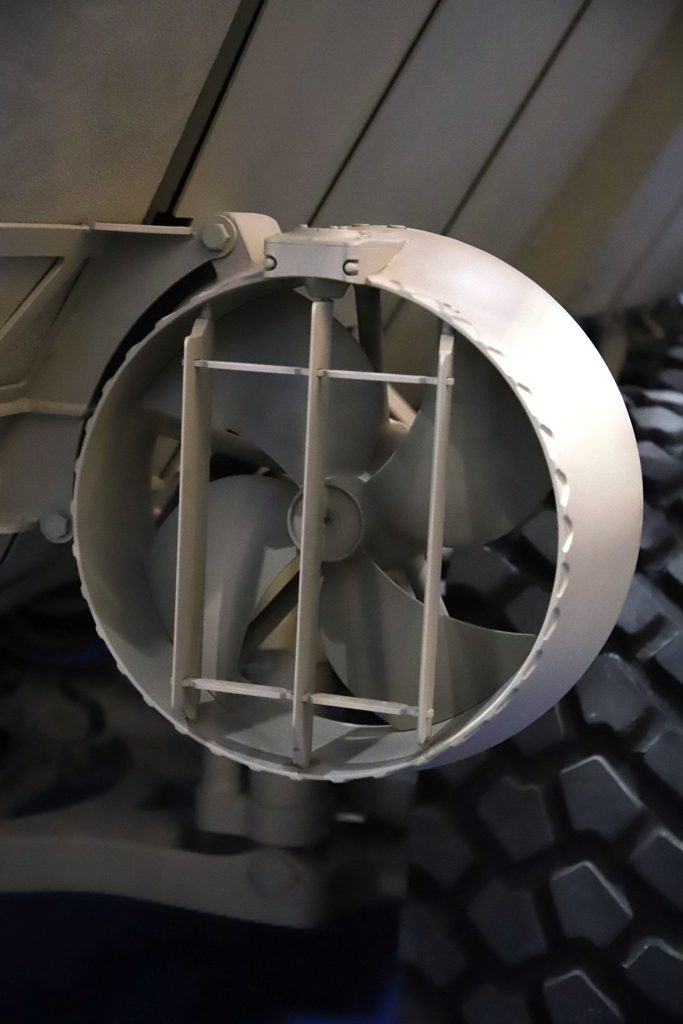
IDEX 2019: Wahash, an 8×8 made in the UAE for the UAE environment
At first glance one has the feeling of a déjà vu, the inclined sides giving it a “V” shape aspect that remembers South African vehicles of the past. In fact, looking closely, the bottom is far from be “V” shaped, Petar Radulovic, Calidus engineering director of the Wahash programme defining it “diamond shape.” The very young designer of this new 8×8, wholly developed in the United Arab Emirates, explains that inclining the sides allows reducing the mass of the vehicle by 30-40 % considering the same protection level. Mobility and protection were the two key focus of the programme which design has been entirely tailored to the UAE climate and scenario, the Wahash being thus able to operate without degradation up to 55°C.
Talking about mobility, the vehicle is fitted with a Scania DC 13 turbodiesel engine providing 724 hp coupled to a ZF 7 AP 2600 SP transmission, the driveline being fitted with a Katsa MKAT100539 transfer case. The propulsion system allows the Wahash to reach a maximum speed of 130 km/h, to climb a 70% slope and move on a 40% side slope. The latter data is reached thanks to the low centre of gravity, a must in an amphibious vehicle, and to the considerable width, 3.1 meters, the vehicle being 8.5 meters long and 2.7 meters high without turret. The independent suspensions are double wishbone with a 2-stage hydropneumatic damper that allows controlling the vehicle in hard turns. Calidus focused a lot on protecting mobility, thus very few pneumatic hoses or electric cables are visible; however should a pneumatic hose of the Knorr-Bremse brake system would be hit, an automatic vale would isolate it, the vehicle thus losing only one brake. This was tested with AP rounds, fragmentation mines and fragmentation hand grenades, showing a considerable reliability. Depending on the mission and on the soil, the Kalle 2-stage suspension allows the driver to increase the already considerable ground clearance, 450 mm, up to 650 mm, the system allowing just two positions, normal and high. The Wahash is equipped with Hutchinson 16R20 tires, fitted with a special runflat insert designed for the desert, where it often happens that the crew lowers the tire pressure to a minimum, this system allowing running with a tire pressure of only 0.7 bars, CTIS being standard issue. The distance between the axles, these being provided by Sisu of Finland, is of 1.6 meters (1-2 and 3-4) and 2.05 meters (2-3), the Wahash being capable of overcoming a 0.8 meters step and a 2 meters trench. The first two axles are steering, a counter-steering fourth axle can be available as option to reduce the turning radius. The range is of 700 km, three fuel tanks being available on board, two at the rear, each hosting 160 litres, and one protected emergency tank of 120 litres, which gives a 150 km spare range.
When afloat propulsion is provided by two propellers visible at the rear, specifically developed to be as light as possible while providing good thrust, maximum speed in water being 8-10 km/h, the Wahash being capable to navigate in State 2 sea and to ford a 2 meters deep river without preparation. The vehicle can swim at a GVW of 32.1 tonnes, 7.5 tonnes of which being the payload, although buoyancy elements must be added, that do not increase the vehicle width. GVW can go up to 34 tonnes without degrading mobility performances, however in this case should the vehicle have the need to swim, buoyancy element would protrude from the flanks increasing the lateral size. When afloat the coolant flow is diverted, a keel cooling element with a water/water heat exchanger being available.
Shifting to protection, as said the inclined sides contribute to provide a good protection while keeping the weight under control. The Wahash has an all round Level 4 ballistic protection, also on the engine compartment. The pilot windscreen is also Level 4, but an opaque ballistic protection which is lowered and raised via a hydraulic system allows to further enhancing protection, vision blocks and a camera being available for driving in those conditions. The Wahash can withstand 50 kg TNT at 5 meters distance as well as a roadside bomb based on a 155 mm artillery grenade. The vehicle has gone through all protection tests, those being certified by an independent entity.
The troops are hosted in a 13.5 m3 protected volume, the driver position and the rear compartment being linked by a corridor on the left of the vehicle, the engine being located forward right. The eight dismounts are seated on TEK energy absorbing seats, while they can keep their feet on the floor, as this is in fact a false floor which avoids the need of footrest. The enter and exit the vehicle from the rear through a left-hinged armoured door, a small stair allowing to easily climb into the vehicle; a ramp is also available as option. The Wahash is designed to allow an easy integration of the BMP-3, a must in all UAE programmes of this type, however at IDEX it was shown with a BM-3M “Shturm-M” combat module; developed by Ukroboronprom, it is armed with an A72A 30 mm automatic cannon, an AG-17 30 mm automatic grenade launcher, a PKT 7.62 mm coaxial machine gun, and two RK-2S antitank missiles.
Currently a second prototype is being built, the existing one exhibited at IDEX being aimed at mobility tests, while that under construction will be engaged in a structured test programme including i.e. climatic chamber, electromagnetic compatibility, etc.
According to Hamas Faris Al Mazrouei, Calidus General Manager, the decision to develop such a vehicle was taken in order to demonstrate the capacity of the country to build an 8×8 on its own development. The aim is not to compete against established vehicle champions around the world but to concentrate on systems designed for the UAE environment.







Photos by Paolo Valpolini

